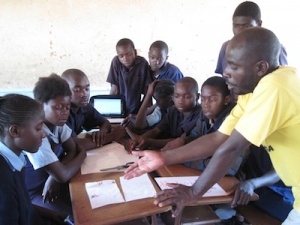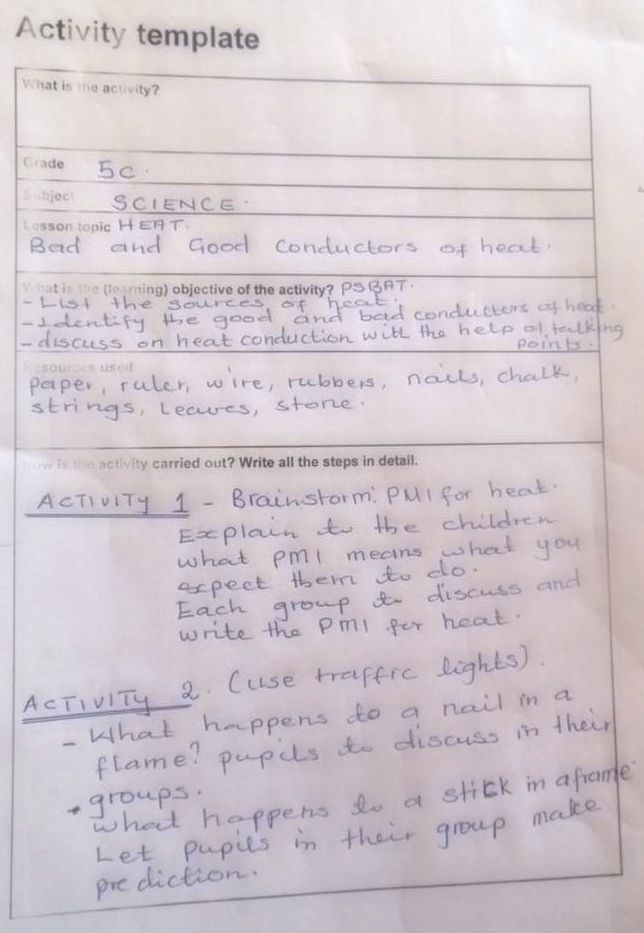Session 1.1 - What is interactive teaching? An introduction to the interactive Zambian classroom
Learning intentions and objectives.
In this session you will learn about:
- the interactive teaching technique of brainstorming, and how and when to use it in the classroom, and
- activity templates for interactive teaching techniques, and how these can be introduced alongside current lesson plans.
Success criteria.
To meet the learning intentions you will:
- plan a brainstorm activity that has the potential to generate lots of ideas,
- complete an activity template for the brainstorm activity that has a clear learning objective,
- do this activity in the classroom, and
- reflect on this activity (and revise, if necessary) to ensure maximum interaction from students.
ICT components.
There are no ICT components for this session — this will start in the next session.
Introduction and ice breakers
![]() Whole class dialogue (30 min): Introduction to the programme.
Whole class dialogue (30 min): Introduction to the programme.
Welcome to the first workshop of the OER4Schools programme. The facilitator will now guide you through some introductory activities.
As part of this, you have the opportunity to discuss
- a weekly time for the workshops,
- whether you are going to use first or second names,
- your expectations,
- whether participants need to come on time, or report in if they are ill,
- keeping a register,
- the use of the ICT equipment, and
- any other suggestions, ideas, and concerns you may have.
Brainstorm on interactive teaching
![]() Whole class brainstorm (10 min) on interactive teaching. Consider the following questions:
Whole class brainstorm (10 min) on interactive teaching. Consider the following questions:
- What is interactive teaching?
- What interactive techniques do you know?
- How often have you used such techniques?
Brainstorming in the classroom
![]() Same-task group work (5 min): Discussion in pairs about what brainstorming(a) looks like in the classroom. Now that we have done a brainstorm in the workshop, what does a brainstorm in the classroom look like? Do you think your students would like this activity? How could you make sure that all students get actively involved? Discuss this with your neighbour.
Same-task group work (5 min): Discussion in pairs about what brainstorming(a) looks like in the classroom. Now that we have done a brainstorm in the workshop, what does a brainstorm in the classroom look like? Do you think your students would like this activity? How could you make sure that all students get actively involved? Discuss this with your neighbour.
![]() Whole class dialogue (5 min): Reporting back from the discussion. Participants briefly report back from the group work.
Whole class dialogue (5 min): Reporting back from the discussion. Participants briefly report back from the group work.
![]() Observing, thinking, reflecting (5 min): Watch video of a brainstorm. Watch the following video clip together. As you watch, think about the following:
Observing, thinking, reflecting (5 min): Watch video of a brainstorm. Watch the following video clip together. As you watch, think about the following:
- What are you noticing?
- At what point(s) in the lesson could this be used?
- What do you think the students are learning from this?
- How are they learning?
- Can brainstorming be used with large classes too, where there isn’t time for everyone to contribute each time? How would you adapt it for this?
- What are the benefits of brainstorming?
- What makes a brainstorm successful?
- What do you think about the teacher's comment "since I want all of you to participate, no hands up, OK"?
VIDEO
A brainstorm naming animals
A brainstorm naming animals. Start of lesson: brainstorm with unique contributions, time to think first, no hands up technique.
Video/Eness vertebrates 1.mp4, https://oer.opendeved.net/wiki/Video/Eness_vertebrates_1.mp4,This video is available on your memory stick in the video/Eness Vertebrates folder. Duration: 2:43 watch on YouTube, local play / download options / download from dropbox)(Series: Eness Vertebrates, episode 01)(Transcript available here or via YouTube captions.)
This clip from a Grade 3 classroom illustrates how the teacher solicits (and records) different students’ views without evaluating them.
![]() Whole class dialogue (15 min): Discussion on the brainstorm video. Let's now discuss this. We asked some questions above, which you should now discuss.
Whole class dialogue (15 min): Discussion on the brainstorm video. Let's now discuss this. We asked some questions above, which you should now discuss.
![]() Observing, thinking, reflecting (5 min): Summary. Summarise, and discuss the proper meaning of what a brainstorm is. You can refer to OER4Schools/activities/brainstorming to find out more.
Observing, thinking, reflecting (5 min): Summary. Summarise, and discuss the proper meaning of what a brainstorm is. You can refer to OER4Schools/activities/brainstorming to find out more.
Planning an activity - “activity template”
![]() Whole class dialogue (10 min): Discussion on activity plans. Have a brief discussion about current practice on lesson planning. Consider such things as: Where do the lesson plans themselves come from? What do you think about the activities that are being done? Can you see a way that new activities could be introduced alongside your current lesson plans? Do you foresee any difficulties in doing this?
Whole class dialogue (10 min): Discussion on activity plans. Have a brief discussion about current practice on lesson planning. Consider such things as: Where do the lesson plans themselves come from? What do you think about the activities that are being done? Can you see a way that new activities could be introduced alongside your current lesson plans? Do you foresee any difficulties in doing this?
![]() Introduction (10 min) to activity templates. In this section, we consider strategies to incorporate new interactive elements in your lessons, including things you might say and do. To help you structure your planning, we provide an activity template. The template includes details of:
Introduction (10 min) to activity templates. In this section, we consider strategies to incorporate new interactive elements in your lessons, including things you might say and do. To help you structure your planning, we provide an activity template. The template includes details of:
- what the activity is (a technique such as a brainstorm, group work, mini blackboard use, plus an activity in which it is used, e.g. “a brainstorm on what animals are found in your environment”),
- the grade,
- the subject & lesson topic,
- what the (learning) objective of the activity is (e.g. to find out what students already know about topic X),
- resources to be used (such as blackboard, mini blackboards, paper, objects, etc.), and
- how the activity is carried out.
![]() Same-task group work (10 min): Planning in pairs for activity templates. Break into pairs, and capture the activity (shown in the video above) in the activity template. Remember to include the 'no hands up(a)' technique - this works very well with brainstorming, but can also be used for general questioning.
Same-task group work (10 min): Planning in pairs for activity templates. Break into pairs, and capture the activity (shown in the video above) in the activity template. Remember to include the 'no hands up(a)' technique - this works very well with brainstorming, but can also be used for general questioning.
Planning a brainstorm activity
![]() Same-task group work (5 min): Planning in pairs of a brainstorm activity. Break into pairs, and plan a brainstorm together. The pairs should be arranged, so that it will be possible to do this brainstorm with your class (e.g. pair by grade, or pair by subject). As you plan, share your ideas with your partner as much as possible, and listen attentively to their ideas and feedback.
Same-task group work (5 min): Planning in pairs of a brainstorm activity. Break into pairs, and plan a brainstorm together. The pairs should be arranged, so that it will be possible to do this brainstorm with your class (e.g. pair by grade, or pair by subject). As you plan, share your ideas with your partner as much as possible, and listen attentively to their ideas and feedback.
Here are some questions you could consider to help you plan:
- What do you need to know about students’ knowledge or understanding of the topic? What will you ask them to brainstorm about?
- What will you do with the results? How will you build on that in the rest of the lesson?
- What are you teaching next week?
- What is the topic of your brainstorm?
- What makes for a good topic?
![]() Whole class brainstorm (5 min) of participant's suggestions. Pick one or two of the brainstorms that were just planned and try them on the rest of the group.
Whole class brainstorm (5 min) of participant's suggestions. Pick one or two of the brainstorms that were just planned and try them on the rest of the group.
![]() Whole class dialogue (5 min): Discussion of the trialled brainstorm activity. Did this work? How do you know? Did everyone participate?
Whole class dialogue (5 min): Discussion of the trialled brainstorm activity. Did this work? How do you know? Did everyone participate?
![]() Same-task group work (5 min): Planning in pairs to revise the planned brainstorm activity. Based on what you have learned from the brainstorm trialling activity, revise your brainstorm, making sure that you have phrased your topic in a way that will generate lots of ideas. You can do this activity in pairs, but each one of you should plan an individual brainstorm activity that you will use with your class before the next session.
Same-task group work (5 min): Planning in pairs to revise the planned brainstorm activity. Based on what you have learned from the brainstorm trialling activity, revise your brainstorm, making sure that you have phrased your topic in a way that will generate lots of ideas. You can do this activity in pairs, but each one of you should plan an individual brainstorm activity that you will use with your class before the next session.
Follow-up activities
![]() Agreeing follow up activities. (5 min).
Agreeing follow up activities. (5 min).
Part A: Practical classroom activities and reflection. Complete an activity template for the brainstorm activity that you planned and revised in this session. Do the activity with your class, and be prepared to reflect on how it went.
Part B: Don’t forget to bring your activity plans again, as well as your recorded reflections. (Use your dictaphone if you have one, or make notes on paper or electronically)
Activity template
The activity template is available on this page for printing: OER4Schools/activity template:
Downloadable version: Activity template.pdf (info)
| What is the activity?
|
| Grade
|
| Subject
|
| Lesson topic
|
| What is the (learning) objective of the activity?
|
| Resources used
|
| How is the activity carried out? Write out all the steps in detail.
|
Here is a photograph of a completed activity template for a lesson on conduction. Note that one template can be used for multiple activities:



